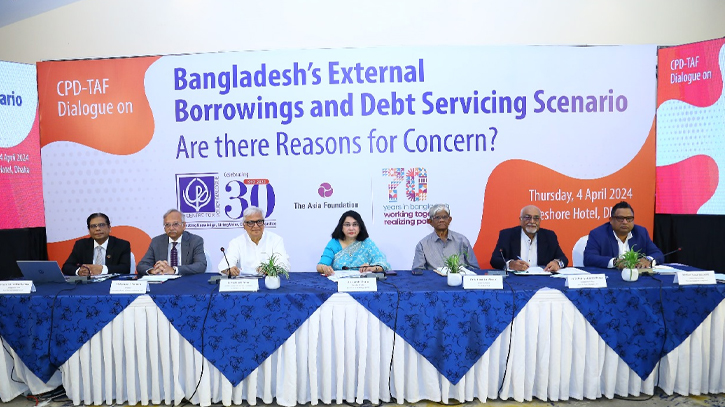
Photo: Collected
Bangladesh finds itself in a precarious fiscal position, with a significant portion of its revenue dedicated to debt repayment, as revealed by Dr. Debapriya Bhattacharya, a distinguished fellow at the Centre for Policy Dialogue (CPD).
According to Dr. Bhattacharya, two-thirds of the government's total debt originates from domestic sources, bringing the per capita debt to an approximate $850.
During a seminar on Thursday, titled “Bangladesh’s External Borrowings and Debt Servicing Scenario: Are There Reasons to be Concerned?” organized by CPD in partnership with The Asia Foundation – Bangladesh, Dr. Debapriya shed light on the complexities of Bangladesh's debt structure. The event took place in a hotel in Gulshan, Dhaka on Thursday (4 April), with Prime Minister's economic adviser Dr. Mashiur Rahman as the chief guest.
Dr. Debapriya emphasized the gravity of the situation, stating, "34 percent of Bangladesh's revenue expenditure till July has been allocated to debt repayment." This figure, he noted, includes 28 percent for domestic debt and 5 percent for foreign debt, marking a significant increase from 26 percent to 34 percent in just three years.
The acceleration of borrowing trends since 2018-19, attributed to the Covid-19 pandemic and the Russia-Ukraine war, has raised concerns about Bangladesh's debt servicing capacity. The revenue budget is now so stretched that it cannot finance a single penny for development projects, he highlighted.
Reflecting on the broader implications of debt repayment, Dr. Debapriya criticized the dismissive attitude of policymakers towards economists' warnings. He recounted his own predictions made two years ago about the challenges facing Bangladesh in 2024, emphasizing the anticipated discomfort in debt repayment starting from 2025 and escalating in 2026.
He also pointed out the significance of private sector debt, noting that government loans account for 80 percent of total borrowing, with the private sector comprising the remaining 20 percent. He stressed the impact of private-sector loans on the country's liability and exchange sector, calling for greater scrutiny of personal loans and their utilization, whether domestically or abroad.
Combining foreign and domestic debts, Dr. Bhattacharya underscored the burden of per capita liability, which stands at $310 for foreign debt alone and escalates to approximately $850 when domestic debt is factored in. This comprehensive analysis of Bangladesh's debt scenario underscores the urgent need for fiscal prudence and strategic planning to navigate the challenges ahead.
Messenger/Sumon








